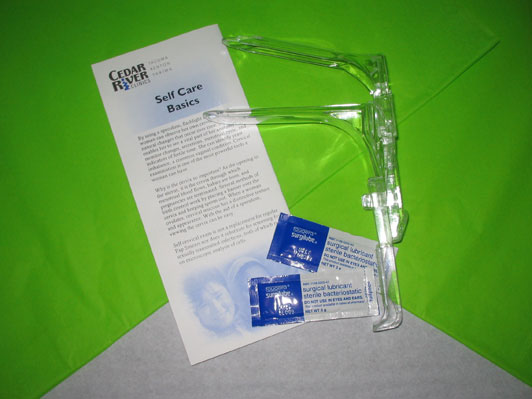Self Care
Why Cervical/Vaginal Self Exam?
By using a speculum, flashlight and mirror, a woman can observe her own cervix and the natural changes that occur over time. Self exam enables her to see a vital part of her anatomy and monitor changes, secretions, menstrual cycle, and indicators of fertile time. She can identify yeast imbalance, a common vaginal condition. Cervical examination is one of the most powerful tools a woman can have.
Why is the cervix so important? As the opening to the uterus, it is the cervix through which menstrual blood flows, babies are born, and pregnancies are terminated. Several methods of birth control work by placing a barrier over the cervix and keeping sperm out. When a woman ovulates, cervical mucous has a distinctive texture and appearance. With the aid of a speculum, viewing the cervix can be easy.
Self cervical exam is not a replacement for regular Pap Smears, nor does it substitute for screening for sexually transmitted infections, both of which rely on microscopic analysis of cells.
3 Easy Steps to
Self Exam
In addition to the hand-held mirror, flashlight, and speculum, you may want KY lubricating jelly or water on the speculum for easier insertion. (Use
a water-based lubricant, not Vaseline.)
Before you start, practice opening and closing the speculum; and make sure you understand how to lock it open, as well as how to unlock and close the bills. Then sit comfortably; leaning back with your legs open, knees up, on a bed or couch with pillows behind you.
(If you don't already have one, get your own clear plastic speculum from FWHC.)
- Put some KY jelly or water onto the bills (the rounded part ) which you will insert into your vagina) . Take a deep breath. As you exhale, let your muscles relax. To insert the speculum, hold it in one hand, handles up, bills together. Using your other hand, spread the labia and insert the bills of the speculum as you would a tampon.
- When you have inserted it as far as it will comfortably go, open the bills using the mechanism on the handles that you practiced with earlier. You will feel the speculum stretch your vagina open. Lock the speculum into place. Then you can let go of it. With both your hands free, you can now hold the flashlight and mirror. Shine the beam of the flashlight into the mirror so it reflects into the vagina lighting up the internal space. Or shine the flashlight directly inside. Adjust the mirror and flashlight so you can see inside. At the back of your vagina is your cervix. It looks like a small donut with a very small opening in the center.
- When you are finished, unlock and close the speculum. Then slowly and gently pull the speculum out. You may smell the speculum to become familiar with your natural smell of secretions and examine the mucus picked up on the speculum. An acidic smell is not unusual. A yeasty or fishy odor may indicate an infection.
What You See
The cervix appears as a rounded or flattened knob about the size of a quarter or half-dollar. The hole or opening in the center is called the cervical os.
If you cannot see your cervix, unlock the speculum , change the direction the bills are pointed, then reopen it. It may help to sit on a firmer surface, like the floor. If after a few tries you are unable to find your cervix, wait a few days and try again. The cervix moves somewhat during the menstrual cycle and may be easier to see in a few days.
What's Normal
Your cervix may be pink and smooth or it might have reddish blemishes. It can also be uneven, rough or splotchy. All of these are normal.
There may be mucus covering the cervix or coming out of the os. Mucus is natural. The character of the mucus changes throughout the menstrual cycle in response to hormones. It ranges from pasty-white (non-fertile) to clear and stretchy egg-white texture (fertile). It does not have a strong odor.
The cervix may have fluid-filled sacs on it that look like blisters. These are called Nabothian cysts and are not a problem. They are caused by a blockage in the mucus-producing glands of the cervix. In some women they come and go, and others have them for years. They do not need treatment.
You may see polyps, outgrowths of tissue that dangle on a stalk and protrude through the os. They may bleed easily but do not need to be removed unless they bother you.
Cervical bluing may be the first sign that a woman is pregnant. Fifty percent of women who are pregnant will have a blue or purplish colored cervix due to an increase in blood circulation. During pregnancy, the cervix may also look puffy and softer and the os more open.
What's Not Normal It is normal to have vaginal and cervical discharge. However, if any of the following are found during self exam, it may indicate an infection.
- green, gray or dark yellow discharge
- any
significant change in the amount or consistency of discharge
- any strong
odor unusual for you.
A health professional can take a sampling of cells and send them to a lab for tests.You may choose to seek care from a clinician
if you suspect an infection. Some infections, such as chlamydia or gonorrhea,
can cause serious complications if left untreated. Other conditions may be easily
addressed with natural remedies.
When you have a Pap test, the clinician removes a few cells from the cervical os . The cells are sent to a laboratory and examined under a microscope for signs of cancer. Your visual exam is not a replacement for a Pap smear.
With the exception of visible sores caused by the herpes virus, most sexually transmitted diseases cannot be seen during self-exam. Chlamydia, gonorrhea, HIV/AIDS, hepatitis - all these STD's need to be tested by a clinician and require prescription medication.
Recognizing what is normal for you is the primary reason for performing self exam. By knowing what is normal, you can tell what is unusual for you.
A "yeast
infection" is an overgrowth of natural vaginal yeast. It can cause a white,
cottage cheese-like discharge and usually causes uncomfortable itching. There
are many ways to curb yeast overgrowth, including garlic vaginal suppositories,
yogurt douches, herbal or natural treatments as well as over-the-counter medications.
Pregnancy and Cervical
Exam
When a woman is pregnant, the cervix
appears bluish or purplish instead of the usual pink.
So, why
self exam? To claim our bodies for ourselves. Self exam can be a transformative experience.
It may be performed individually or in a group where the experience may be shared and each person in the group can learn more about the wide range of what is normal for women. Some women do it every week, some once a month, some only occasionally.
Self exam can be more than simply knowing the appearance of your cervix. It can be a tool for self-discovery and empowerment.
To know what was once unknown, to shed light on what was once hidden, and to have a sense of ownership and ability to care
for our bodies can change our lives.
It's about helping ourselves to health.
Get
your own plastic speculum.

more info:
updated
July 13, 2011
The
U.N. has figured out that $16 trillion worth of women's work -- in the home, in
the family fields, in child care -- is unpaid and undervalued when computing global
economic statistics.
Feminist Women's Health Center |